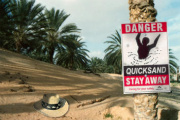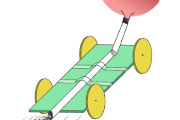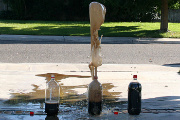Stars are so much more than pretty lights in the night sky. They act as both a compass and a clock. For hundreds of years people have relied on the stars to navigate the ocean and to know when to plant their crops or perform religious ceremonies. To make the stars easier to read, these people grouped the brighter stars in to recognizable patterns—constellations.
If you were to play connect-the-dots with the constellations, they would each resemble a different object. For example, the constellation Draco looks like a dragon with a small, pointed head and a long, curving body. Perhaps the most famous and distinguishable constellations are the Ursa Major and Ursa Minor, better known as the big and little dippers. Depending on the time of year, the constellations will appear in different positions in the night sky.
Step 1: Create a Hypothesis
The purpose of this science fair experiment is to determine if it’s possible to make two models of the Northern Hemisphere’s night sky, one of the Spring sky and one of the Fall.
Step 2: Gather Your Materials
For this project, you’ll need the following:
- Black poster paper
- Luminous white paint
- Tracing paper
- Ice pick
- Glue
- Scissors
- A star chart
Step 3: Follow the Procedure
- First, search the internet or an astronomy book for two maps of the Northern Hemisphere’s night sky, one of the Spring sky and one of the Fall sky. Then trace the constellations onto tracing paper.
- Cut your poster paper into 28 wedge-shaped segments, each exactly the same size.
- Glue 14 of the segments together so that the points meet at the center creating a circular pattern. You’ll need to cut small incisions into the sides of each wedge so that they can interlock and glue together properly. Repeat this with the other 14 segments.
- Place your tracing paper in the center of wedges. Use your ice pick to punch holes through your tracing paper and poster paper. You are creating the stars. Using your luminous white paint, connect the lines of each constellation.
- Fold another piece of poster paper into a circular tunnel about 12 inches wide. Fold down the ends of your wedges and glue them to one end of the tunnel, creating a dome. When you’re finished you should be able to hold the dome up to the light and see the small holes glowing like stars in the night sky.
Step 4: Gather Your Results
Once you have successfully created both domes, you can conclude that it is possible to create your own replica of the night sky. In a dark room, you’ll see the luminous paint outlining the constellations, and in a bright room, you’ll see the stars themselves. (If your teacher requires a graph, create of bar graph showing the number of stars found in each constellation you used in the experiment.)
Related Stories:
- Feet: A Smelly Science Fair Project
- Science Fair Projects Examples & Ideas
- More Amazing Science Fair Projects
- The Science of Farting

































